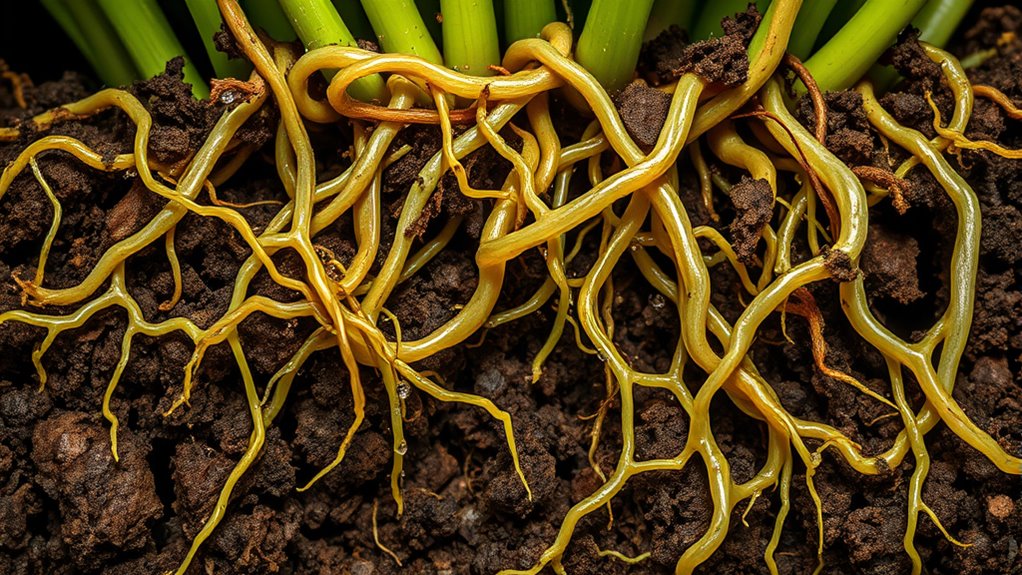Mycorrhizal fungi form crucial underground partnerships with your plant roots, extending their reach through complex networks. These fungi create hyphae that infiltrate soil, increasing surface area and helping your plants access nutrients like phosphorus and nitrogen more efficiently. They also boost water absorption and strengthen plant immunity. By supporting these fungi, you enable your plants to grow healthier and more resilient. Keep exploring to learn how you can foster these essential underground allies.
Key Takeaways
- Mycorrhizal fungi form symbiotic relationships with plant roots, creating extensive hyphal networks underground.
- They extend root systems beyond visible roots, increasing access to water and nutrients like phosphorus and nitrogen.
- Fungal hyphae infiltrate soil pores, significantly enlarging the surface area for nutrient absorption.
- These networks connect multiple plants, facilitating nutrient sharing and communication underground.
- By enhancing soil structure and microbial diversity, mycorrhizal fungi support healthier, more resilient plant growth.

Mycorrhizal fungi form an essential partnership with plant roots, enhancing their ability to absorb water and nutrients from the soil. This symbiosis considerably impacts soil health, as these fungi create extensive fungal networks that connect multiple plants and facilitate nutrient exchange. When you understand how these underground allies operate, you realize that healthy soil isn’t just about the right minerals but also about fostering the right microbial communities. The fungi extend the root system far beyond what you see above ground, forming a web of filaments called hyphae that infiltrate the soil and increase the surface area available for absorption. This network allows plants to access nutrients like phosphorus and nitrogen more efficiently, especially in nutrient-poor soils, which helps promote robust growth and resilience. Additionally, these fungal networks help improve soil structure by promoting aggregation and reducing erosion. The fungal networks act as underground communication highways, linking plants together and enabling the transfer of nutrients, water, and even signaling molecules. This interconnected system can boost your plants’ immune responses, making them more resistant to pathogens and environmental stresses. When soil is healthy, these networks thrive, supporting a diverse microbial community that keeps the soil fertile and balanced. By cultivating soil health through practices like reduced tillage, organic amendments, and avoiding synthetic chemicals, you encourage the proliferation of beneficial mycorrhizal fungi. This, in turn, strengthens the fungal networks, creating a more resilient and productive root system for your plants. You play an essential role in maintaining this underground harmony. When you plant in healthy soil and avoid disrupting these fungal networks, you’re allowing the mycorrhizae to establish and expand naturally. As the fungi grow, they form a symbiotic relationship where your plants supply the fungi with carbohydrates, and in return, the fungi enhance nutrient and water uptake. This partnership not only improves plant health but also contributes to soil structure by promoting aggregation and reducing erosion. The more diverse and abundant your soil microbiome, the more extensive and effective these fungal networks become, creating a dynamic system that supports sustainable growth. Recognizing the importance of microbial diversity and fostering it can significantly maximize the benefits of mycorrhizal fungi in your garden or farm. In essence, by supporting the development of mycorrhizal fungi and their networks, you’re investing in a natural system that benefits both your plants and the soil itself. These underground allies are essential for building soil health, increasing nutrient availability, and fostering a thriving ecosystem beneath your feet.
Frequently Asked Questions
How Do Different Soil Types Affect Mycorrhizal Fungi Effectiveness?
Different soil types markedly impact mycorrhizal fungi effectiveness by affecting soil nutrients and fungal diversity. You’ll find that nutrient-rich soils support diverse fungi, boosting plant health, while poor soils limit fungal growth, reducing benefits. Sandy soils may drain quickly, hindering fungi, whereas clay soils retain moisture but can restrict root expansion. To maximize fungi benefits, you should consider soil amendments that enhance nutrient availability and promote fungal diversity.
Can Mycorrhizal Fungi Benefit All Plant Species Equally?
Not all plant species benefit equally from mycorrhizal fungi due to plant species compatibility and fungi diversity. Some plants form strong partnerships, enhancing nutrient uptake, while others have limited interactions. You’ll find that certain fungi are more compatible with specific plants, so understanding these relationships helps optimize benefits. By selecting the right fungi for your plant species, you can maximize growth and resilience, making your garden more productive and healthy.
How Long Does It Take for Fungi to Establish Symbiosis?
Think of your plant and fungi as dancers starting a slow, intimate waltz. Usually, the timing establishment for symbiosis development takes a few weeks, often around 2-4 weeks, depending on conditions. During this period, the fungi and roots communicate and synchronize, building trust and connection. Patience is key because, in this dance, a strong partnership emerges only with time and care, creating a thriving underground alliance.
Are There Environmental Conditions That Hinder Fungi-Plant Relationships?
Yes, environmental conditions can hinder fungi-plant relationships. You’ll find that pH sensitivity affects fungi’s ability to thrive; too acidic or alkaline soils can prevent proper colonization. Chemical interference from pollutants or fertilizers can also disrupt the symbiosis, making it difficult for fungi and plants to connect effectively. To promote healthy relationships, guarantee your soil has balanced pH levels and limit chemical disturbances around your plants.
How Can I Introduce Mycorrhizal Fungi to My Garden?
To introduce mycorrhizal fungi to your garden, start by purchasing soil inoculants that contain fungal spores. Mix these inoculants into your garden soil according to the package instructions, ideally before planting. This helps establish beneficial fungi early on, promoting plant growth and health. Make certain your soil isn’t overly fertilized with chemicals, as this can hinder fungi development. With proper application, you’ll encourage a thriving underground partnership for your plants.
Conclusion
Think of mycorrhizal fungi as secret allies beneath the soil, quietly extending your plant’s reach like unseen hands. When I watched a young sapling thrive after forming a fungal partnership, it was like discovering a hidden network of support. These underground allies boost your plant’s roots by up to 700%, turning a simple seed into a resilient giant. Embrace these fungi, and watch your plants flourish as if guided by nature’s unseen, unstoppable force.










